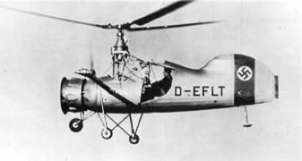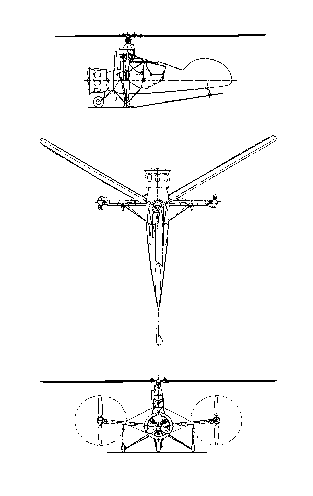
""
FLETTNER
ANTON
|
FL-185 |



|
|
|
Al
desarrollo del FL-184 le siguió el
FL-185 Heliogyro, una mezcla de autogiro y helicóptero. El contrato de
desarrollo fue asegurado por RLM
en febrero de 1937; dos tipos SV fueron planeados, dándole la designación
de “Helicopter Conversion 184” en el Programa de Desarrollo de
Aeronaves, debido a que el Fl-184 V3 fue utilizado en la construcción
del Fl-185V1. El proyecto fue financiado con el monto del seguro
recibido de la destrucción del Fl-184 y el apoyo de RLM. El rotor
principal constaba de tres palas con dos hélices de paso variable
montadas sobre los costados del fuselaje. El motor se alojaba en la
trompa de la aeronave y era un Siemens-Halske
Sh 14A de 140 hp. Para el vuelo
como helicóptero la mayor potencia se destinaba hacia el rotor
principal y una pequeña parte hacia la hélice que estaba ubicada al
costado de la aeronave para compensar el efecto contrarrotatorio (ver
foto). También podía ser utilizado solo como autogiro, y en este caso
la potencia del motor se destinaba a mover la hélice principal. Este
prototipo (D-EFLT) voló, pero los trabajos fueron rápidamente
abandonados a favor de un nuevo concepto de Anton Flettner. El único prototipo cumplimentó unos cuantos vuelos en 1938 y aunque
los resultados fueron favorables, todas las pruebas se desarrollaron
cerca del suelo. |
|
|
|
Following the end of the Fl-184, Flettner designed the single place
Fl-185 Heliogyro, a composite
helicopter-autogyro. The development contract for the Fl-185 was issued
by the RLM in February 1937; two SV-Types were planned. it was given the
designation "Helicopter Conversion 184' in the Aircraft Development
Program, because the planned Fl-184 V3 was used in the construction of
the Fl-185V1. The project was financed with the insurance sum received
from the destroyed Fl-184V1 and a grant from the RLM. It had a single three
blade rotor along with two variable pitch propellers mounted on
outrigger arms off the fuselage. A 140 hp. Siemens-Halske Sh 14A engine
was enclosed in the nose of the fuselage and its engine drove a cooling
fan and a gearbox. For flight as a helicopter the majority of the power
went to the rotor, with a small amount transferred to the two outrigger
propellers which produced thrust in opposite directions to counteract
the rotor torque. The Fl-185 could also be rigged to act as an autogyro
while in forward flight and, in this configuration, the rotor was
unpowered. All the power (except that of the cooling fan) was
transmitted to the outrigger propellers which, in this configuration,
produced thrust in the same direction. This was probably the first use
of fully reversing propellers on an aircraft. one Fl-185 prototype,
D-EFLT, was built and flown, but work was soon stopped on it in favor of
a new concept by Anton Flettner. The sole prototype carried out a number of flights in 1938. Results were favorable, although all test were made in close proximity to the ground. Thanks to germanvtol.com |
|
|
|
Characteristics |
Information |
Characteristics |
Information |
| First
Flight Primer Vuelo |
1938 | Engine Motor |
1 Siemens - Halske |
| Seating
Capacity Plazas |
1 |
Power Potencia |
140 HP |
| Empty
Weight Peso Vacío |
770 Kg |
Hover
Ceiling O.G.E. Estacionario O.G.E |
Ft |
| Maximum
Weight Peso Máximo |
900 Kg |
Hover
Ceiling I.G.E. Estacionario I.G.E |
Ft |
| Vel.
Cruise Vel. crucero |
Kts |
Service
Ceiling Techo de Servicio |
Ft |
| V.N.E. V.N.E |
Kts |
Maximum
Range (Std) Alcance (Std) |
NM |
Copyright © 1999 / 2003